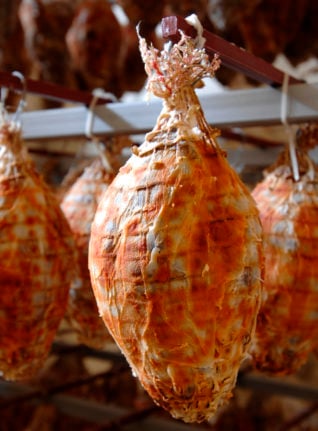It’s pretty clear that Italians are proud and protective of their cuisine – and they should be – but often they go too far.
In Italy food isn’t just a mouthwatering matter. It’s a serious issue; perhaps sometimes too serious.
There are dozens of unusual food protection lobbies everywhere across the boot. Secret societies, academies and brotherhoods are out to tell the world that their signature dish and ancient recipes are sacred, untouchable. And that any counterfeit, imitation or adaptation is heresy.
But these purist food crusaders are, in my view, spoiling the spontaneity of Italian traditional cuisine. It would be one thing to add peanut butter to tortellini, which is indeed heresy, but another thing to make the tortellini just slightly larger than the size of a ring finger (which is how die-hard housewives make it).
The ‘Ventricina Academy’, based in Abruzzo, protects an ugly-looking, huge reddish spicy salami – Ventricina – made with pig meat, black pepper, capsicum, chili and fennel seeds. The academy ensures a tight regulation for producers and protects the cold cut at European level, boasting that its region of origin is Abruzzo. But neighboring Molise also claims paternity over ventricina, and is fighting Abruzzo over it.
There are a few differences between the two regional products, how they’re made and with which ingredients. Molise salami-makers add more capsicum while in Abruzzo there’s more hot chili pepper.

Regional pools of experts and nutritionists are analysing specific characteristics of their premium Ventricina, while local authorities have waged war against each other with salami propaganda including leaflets, handouts and food fairs where butchers call visitors to offer them a free taste of their specialty. I doubt any gourmand traveller could tell one variant from the other.
It is a fascinating story that tells us so much about Italy and how so-called provincialism is mainly about food. And the absurdly extreme lengths locals go to promote indigenous delicacies.
MORE OPINION:
- Why Michelin-starred cuisine is just not suited to Italy
- Want to eat well in Italy? Here’s why you should ditch the cities
Last time I visited Bologna I met a bunch of real ‘Azdore’: Italian cook-warriors who defend their sacred art of handmade pasta, menacingly waving rolling pins in the air.
They showed me the exact movements of the hands needed to make a perfect tortello, tortellino, lasagne and tagliatelle, saying that if you roll a tortellino around the middle or index finger to shape it just won’t be.. a tortellino anymore.
In Bologna you’ll also find the ‘Wisemen Brotherhood of the Tortellino’ who are deadly serious about the city’s copyright of this ring-shaped stuffed pasta which, as legend has it, was inspired by Venus’ belly button.
The ‘wisemen’ tell you how to eat tortellino: exclusively in a thick capon broth. If you mix tortellini with meat ragù like normal pasta, you’re committing a sacrilege.

Even desserts are taken seriously. Treviso’s Tiramisù academy protects the original recipe of Italy’s iconic dessert, which must be without coffee, and claims it was born in the town’s brothels as an energizer for clients.
However, the Friuli region also claims the paternity of tiramisu, albeit with a different recipe and served in a cocktail glass. Anyway, they’re both delicious, and I doubt anyone would be upset if they’re served a ‘non-original’ tiramisu.
While many neighboring towns bicker over which has the best fish soup – if Vasto or Termoli, for instance – and have set up scientific committees to ascertain this, other places have founded associations to protect their native recipes.
The Confraternity of the baccalà alla Vicentina (stockfish cooked the Vicenza way) is a brotherhood of chefs and food experts in Sandrigo, in the Veneto region, that venerates ‘Viking’ stockfish, imported in the 15th century from Norway.
Its members, who believe codfish must be cooked in a certain way, wander across Italy and Europe dressed in a stockfish knight uniform in search of followers.
New brothers are blessed at a yearly ceremony involving a mummified stockfish, and become ambassadors who travel the world – one even on a kayak – to spread the gospel of how to prepare the Vicentina stockfish soup.
The confraternity oversees a chain of restaurants, and they’re very strict: if one chef happens to cook the cod for two hours instead of four, his restaurant gets kicked out of the club.

And even panettone remains a sacred treat – in spite of recent wacky twists on the recipe such as adding aubergines and olives.
The original recipe is fiercely defended by Milan’s Chamber of Commerce, where it was registered over fear of counterfeits. The city hall has a list of approved historical artisan boutiques selling the one and only original panettone year-round, meaning that if you don’t buy it in Milan you’ll be eating a fake.
But there’s no need to look at extravagant foods to understand how such food fetishism can become a bit ridiculous and obsessive, and even downgrades the importance of culinary tradition.
Take simple pizza. Pizza is like bread. You eat it everywhere in Italy; however, fanatical pizza makers claim the ‘real’ Neapolitan pizza made according to regulations (the crust and thickness having specific dimensions) can be savored only in pizzerias that boast a special label.
I’ve had great pizzas everywhere in Italy: thin, thick, round, rectangular. I only judged it based on whether I liked it.
Traditions are important but food must be enjoyed, and you don’t need to be a culinary academic or gourmand to appreciate a good slice of salami.




 Please whitelist us to continue reading.
Please whitelist us to continue reading.
Member comments